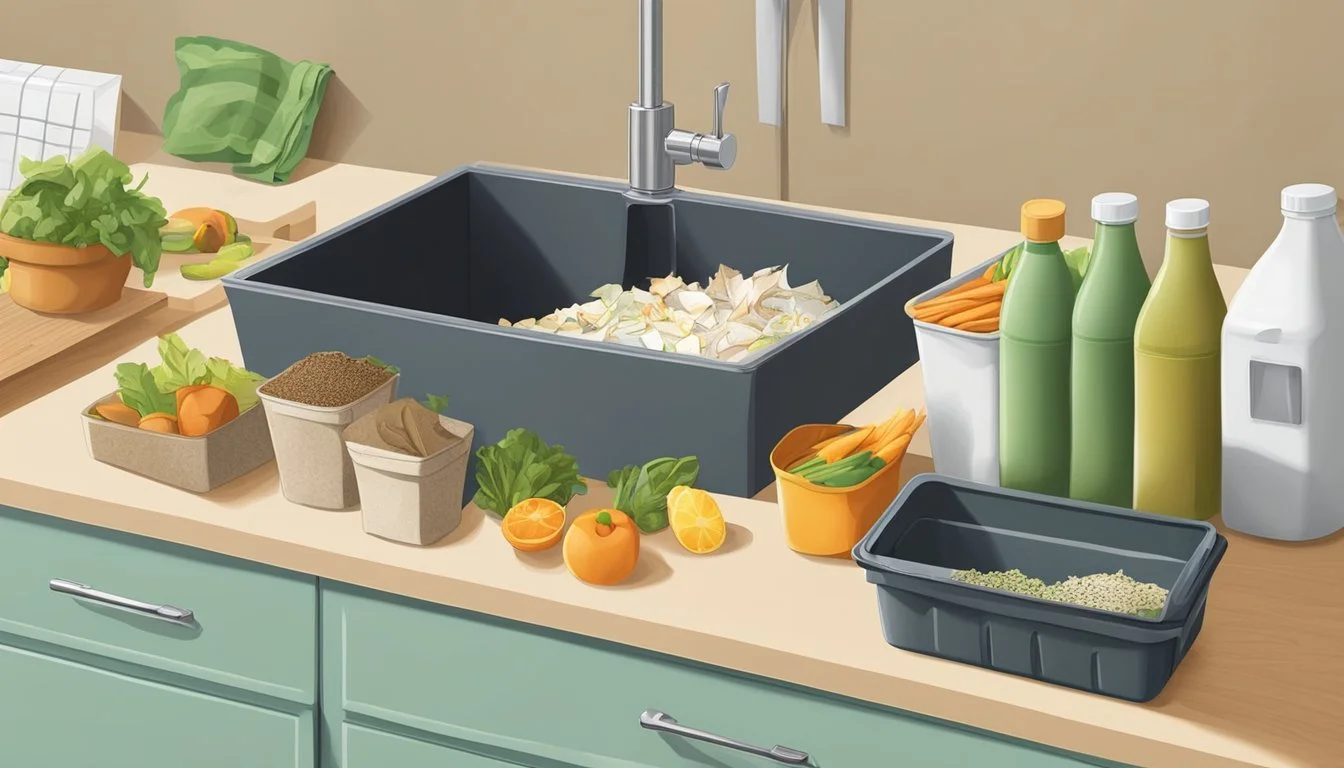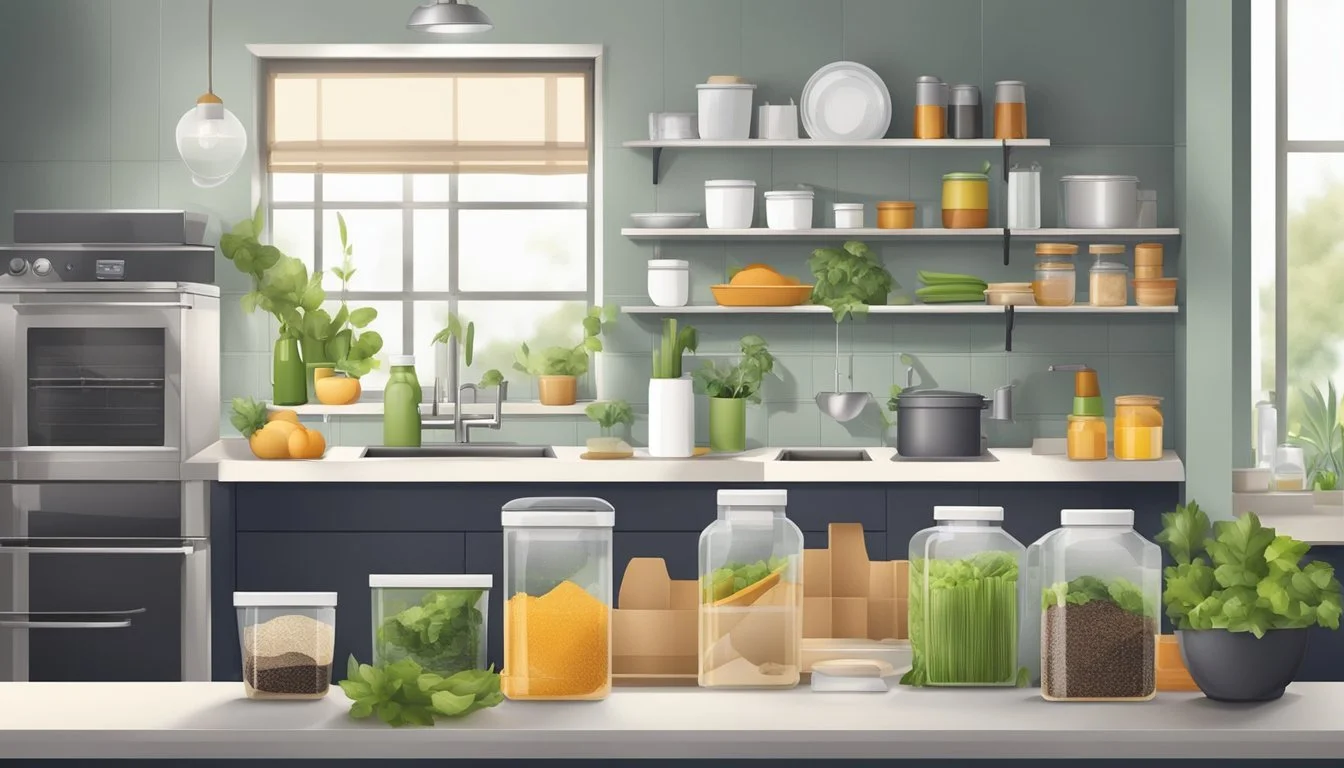How to Create a Zero-Waste Kitchen
Simple Steps for Sustainable Living
The concept of a zero-waste kitchen revolves around minimizing the environmental impact by reducing the amount of waste generated from daily activities related to food preparation and consumption. With food waste at an all-time high and the growing concern over the use of plastics and disposables, there's a pressing need for more sustainable practices in the heart of the home—the kitchen. Transforming a kitchen to follow zero-waste principles involves a series of conscious decisions and actions toward sustainability, from opting for reusable alternatives to effectively managing leftovers and food scraps.
Individuals looking to adopt a zero-waste lifestyle often begin with their kitchen because it's an area ripe with opportunities to cut down on waste. The kitchen is traditionally a major source of household waste, from discarded food packaging to uneaten food. By focusing on reusables, being mindful of food purchases, and engaging in smarter food storage techniques, household waste can be significantly reduced. Moreover, this transition not only benefits the environment; it can also lead to financial savings due to less food being thrown away and fewer products being bought on impulse.
Understanding Zero-Waste Kitchens
A zero-waste kitchen embodies the philosophy of sustainable living by minimizing the waste produced during food preparation, consumption, and storage. It's a practical application of the zero-waste lifestyle, aiming for environmentally friendly practices that reduce one's carbon footprint.
Components of a Zero-Waste Kitchen:
Bulk Purchases: By selecting food sold in bulk, consumers can avoid unnecessary packaging, which is often non-recyclable.
Reusable Items: Swapping single-use items for reusable ones, like silicone lids, beeswax wraps, and cloth towels, supports long-term sustainability.
Composting: Organic waste such as vegetable peels and coffee grounds are diverted from landfills and transformed into nutrient-rich compost.
Benefits:
Reduces Pollution: Decreasing landfill contributions mitigates the release of methane, a potent greenhouse gas.
Conserves Resources: Using fewer disposables means a lower demand for raw materials, preserving natural resources.
Promotes Mindfulness: This approach encourages thoughtful purchasing, reducing food waste and overconsumption.
Challenges:
It's important to note that achieving a completely zero-waste kitchen is a process that involves ongoing effort. Accessibility to bulk stores and sustainable products varies geographically, which can be a hurdle. However, incremental changes contribute significantly to the broader environmental goals.
In summary, the zero-waste kitchen is a critical step in aligning everyday actions with eco-conscious goals. By implementing these changes, individuals can make a tangible impact on their environmental footprint, paving the way for a cleaner future.
Assessing Your Kitchen's Waste Profile
Before initiating waste reduction strategies, one must identify the current waste situation in the kitchen. The initial step is to categorize the types of waste generated. Common categories include food waste, packaging waste, and plastics.
For a thorough assessment, they should inspect their kitchen to tally the quantity and type of waste. Here is an example of how they might break down the waste:
Food Waste: spoiled produce, leftover meals, and food scraps.
Packaging Waste: cardboard boxes, plastic wrappers, and cans.
Plastics: bottles, containers, and single-use utensils.
To organize their findings, individuals might create a table like the following:
Waste Category Description Example Items Food Waste Organic waste from food spoilage and preparation Spoiled fruits, vegetable peels Packaging Waste Non-organic waste often used to wrap or contain food products Plastic wrap, cardboard boxes Plastics Waste composed of various types of plastics, often single-use Plastic bottles, grocery bags
During this phase, individuals should consciously monitor their purchasing habits to pinpoint where they can reduce excessive packaging or single-use items. They should also analyze the disposal methods they currently employ for different types of waste, which will later help them implement appropriate zero-waste solutions.
By understanding one's waste profile, they can set clear and practical goals towards creating a zero-waste kitchen environment.
Waste Reduction Strategies
In transitioning to a zero-waste kitchen, it's crucial to focus on practical strategies that reduce waste and save money while also considering environmental impacts such as carbon footprint and landfill waste.
Composting Essentials
Composting is the cornerstone of organic waste reduction. One can start by segregating food scraps like vegetable peelings, eggshells, and coffee grounds. Using a compost bin helps turn this biodegradable waste into valuable fertilizer for gardens, enriching soil without contributing to landfill waste.
Sustainable Shopping Habits
Shopping with sustainability in mind is key to low waste. Embrace bulk shopping to reduce packaging and utilize reusable bags or containers when purchasing items such as nuts, pasta, or beans. Support local farmers and markets to cut down on transportation emissions linked to your carbon footprint.
Food Preservation and Storage
Properly storing foods extends their life and reduces waste. Use mason jars, silicone bags, or beeswax wraps as alternatives to plastic containers. Glass containers and the freezer are effective for keeping leftovers and bulk-purchased foods fresh longer, helping minimize waste.
Eco-Friendly Kitchen Tools and Materials
Investing in zero-waste kitchen swaps—like bamboo utensils, metal straws, and silicone baking mats—reduces reliance on single-use plastics. Utilize cloth napkins and reusable shopping bags to further diminish everyday waste.
Mindful Meal Prep and Planning
One can greatly reduce food waste with foresight in meal planning. Outline meals for the week, make a specific shopping list, and only buy what's necessary. This ensures minimal over-purchasing and uses up ingredients before they spoil.
Responsible Disposal Practices
Learn about recycling protocols and dispose of non-compostable and non-reusable items responsibly. Aim to differentiate between recyclable, compostable, and biodegradable products to ensure proper disposal, thereby reducing landfill waste and promoting a healthier planet.
Alternatives to Single-Use Products
Creating a zero-waste kitchen involves replacing single-use products with alternatives that champion sustainability and reuse. This section explores dependable items that not only reduce waste but also contribute to a sustainable living environment.
Replace Disposable with Reusable
One can opt for reusable bags instead of disposable plastic ones, favoring materials like cloth which are durable over numerous uses. For storage, transitioning to glass jars and stainless steel or silicone containers supports zero-waste goals while keeping food fresh. Instead of single-use paper napkins and towels, one might select cloth napkins and reusable paper towels, which can be washed and used repeatedly.
Reusable Swap Examples:
Single-use plastic bags -> Cloth totes, cotton mesh bags
Plastic storage containers -> Glass jars, stainless steel tins
Sandwich bags -> Silicone bags
Paper towels -> Microfiber cloths, linen towels
Plastic water bottles -> Metal or glass water bottles
Understanding Biodegradable Options
Biodegradable products serve as a commendable bridge between single-use and reusable items when the latter are not available. Compostable waste bags, biodegradable utensils made from materials like bamboo, and organic beeswax wraps offer a temporary alternative with minimal environmental impact, eventually breaking down without leaving harmful residues.
Biodegradable Products Worth Considering:
Traditional plastic wrap -> Beeswax wraps
Plastic utensils -> Bamboo or compostable cutlery
Plastic plates -> Biodegradable or compostable plates
Emphasizing these alternatives not only helps in reducing the reliance on single-use plastics but also promotes a lifestyle that's deeply rooted in the principles of zero-waste and sustainable living.
Green Cleaning Solutions
Transitioning to a zero-waste kitchen involves rethinking cleaning habits and the products used. Many conventional cleaning products contain toxic chemicals which can be harmful to both the environment and human health. Eco-friendly cleaning products, however, are designed to reduce these negative impacts. Consumers can opt for products with biodegradable ingredients that minimize microplastics and other pollutants in waterways.
For a green clean, one can create effective homemade solutions. For instance, white vinegar is an excellent natural disinfectant and deodorizer. A simple mixture of vinegar and water can tackle many household cleaning tasks without the residue of toxic chemicals.
Natural Cleaner Instructions Usage Vinegar Solution 1:1 vinegar to water Glass, counters, deodorizing Baking Soda Paste Baking soda with a small amount of water Stubborn stains, grout cleaning
Microfiber cloths or rags can replace disposable paper towels, reducing waste and offering a reusable solution. These cloths can trap dirt and dust effectively and can be washed and reused repeatedly.
To address the issue of microplastics, it is advisable for one to avoid cleaners with plastic packaging or synthetic fragrances. Instead, people can seek out products in glass or metal containers or purchase in bulk.
In summary, by integrating eco-friendly cleaning products and homemade solutions, individuals can maintain a clean kitchen while supporting a more sustainable, zero-waste lifestyle.
Budgeting for a Zero-Waste Kitchen
Creating a zero-waste kitchen can lead to sustainable living while also having the potential to save money in the long run. Starting this journey may seem expensive at first, but with strategic planning, one can manage costs effectively.
First, individuals should assess their current kitchen inventory and identify areas where waste can be reduced. Bulk buying, for instance, not only cuts down on packaging but can also be cheaper than purchasing pre-packaged items. It's essential to prioritize purchases based on necessity to avoid unnecessary spending.
Here’s a simple breakdown to budget effectively:
Initial Investment:
Reusable utensils and containers
Water filters to minimize plastic bottle usage
Sustainable cleaning products
Ongoing Costs:
Bulk food purchases
Compostable materials
Long-Term Savings:
Reduced expenditures on single-use items
Savings from decreased food waste
It's advisable to repurpose items they already have instead of buying new. This includes using glass jars for storage or turning old rags into cleaning cloths, thus minimizing spending on specialized products.
Investing in a compost system can trim down garbage collection fees and provide free, nutrient-rich soil for gardens. Budget-conscious individuals can even start with a simple countertop compost bin.
For those concerned about the potential financial outlay, it is important to remember that the cost of zero-waste products typically spreads over time. The durability and reusability of these items often equate to fewer replacements and less frequent purchases. By meticulously evaluating spending and prioritizing eco-friendly practices, they can maintain both a zero-waste kitchen and a balanced budget.
Community Engagement and Support
Creating a zero-waste kitchen extends beyond the confines of one's home and involves engaging with the local community. When a household commits to zero-waste principles, it's beneficial to build relationships with local farmers who practice sustainable agriculture. Supporting local farmers markets not only reduces the carbon footprint associated with long-distance food transportation but also ensures fresher produce that lasts longer, ultimately reducing food waste.
Connect with Local Producers: By purchasing from nearby farmers, one supports responsible land management and can learn firsthand about the crops and methods used.
The community can play a significant role in fostering a zero-waste mindset. Local classes on composting, seasonal cooking, and sustainable practices promote desirable consumption patterns and encourage residents to make informed decisions that benefit both the environment and society.
Participate in Community Initiatives:
Joining community gardens.
Attend workshops on waste reduction.
Volunteering in local environmental drives.
Moreover, zero-waste kitchens thrive on a culture of sharing and reusing. Community swap events are excellent opportunities to exchange surplus items without wastage, whether it's sharing unused ingredients before they expire or exchanging homegrown produce.
Engage in Swap Events:
Share kitchen tools or appliances.
Exchange surplus produce or homemade foods.
Offer cuttings or seeds from your garden.
Through these actions, one takes an active role in a wider sustainable ecosystem, fostering a circle of support that benefits all members and helps to maintain a consistent approach to waste reduction.
Measuring Your Zero-Waste Impact
When embarking on a journey toward a zero-waste kitchen, it is essential to quantify the impact to understand the benefits and motivate continued effort. Individuals should assess their progress by examining key indicators such as reduction in waste output, carbon footprint reduction, and the decrease in greenhouse gas (GHG) emissions.
Waste Reduction: Track the volume of waste not sent to the landfill, such as plastics and non-compostable materials. This can be measured by the number of trash bags saved per week.
Carbon Footprint: Evaluate changes in carbon footprint by considering the energy saved from fewer garbage truck pickups and the decrease in waste processing.
Greenhouse Gas Emissions: Composting organic waste reduces methane emissions, a potent GHG, from landfills.
Activity Pre-Zero-Waste Impact Post-Zero-Waste Impact Trash Output X bags/week Y bags/week Composting 0 lbs/week Z lbs/week Plastic Use X items/month Y items/month
Employing sustainable practices, such as purchasing environmentally friendly products, contributes to a more significant impact. They can use carbon footprint calculators designed for domestic waste to estimate the broader environmental effects of their zero-waste kitchen practices.
Continuous Improvement
Adopting a zero-waste lifestyle in the kitchen is a journey of ongoing refinement. Households that aim for sustainable practices must engage in self-monitoring to consistently reduce waste. It begins with the acknowledgement that waste reduction is a progressive process call for patient, persistent effort.
Practical ways to foster continuous improvement include:
Assessing: Regularly evaluate kitchen habits to identify areas of waste.
Educating: Stay informed about new low-waste products and methods.
Implementing: Gradually introduce sustainable alternatives into daily routines.
A kitchen audit, conducted once a quarter, helps track progress towards waste reduction goals. They should note the volume of waste generated and types of waste that predominate. This insight guides them in tweaking daily habits and shopping choices to lean further into a low-waste lifestyle.
Households may use these findings to refine their approach:
Composting: Improve separation of organic matter for compost.
Recycling: Optimize the recycling system to minimize contamination.
Reusable Items: Switch single-use items for reusable counterparts.
It's essential to celebrate small victories in waste reduction to maintain motivation. For example, successfully composting all organic waste for a month or fully transitioning to bulk-bin shopping are milestones that signify progression in the zero-waste journey.
Overall, continuous improvement in the zero-waste kitchen revolves around a persistent commitment to sustainable practices. By assiduously examining and adjusting behaviors, they make tangible strides towards a more eco-friendly home.






